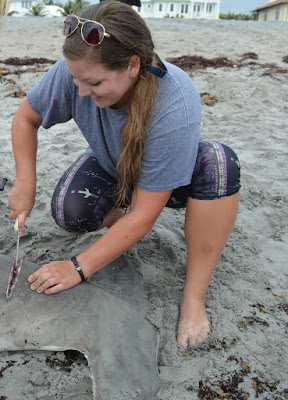Shark Biomechanics
Sarah Hoffmann, Florida Atlantic University
Hi All,
I am a Ph.D. candidate at Florida Atlantic University (FAU)
working on shark biomechanics. My field is a bit off the beaten path in terms
of fisheries science, but I have been lucky enough to work with NMFS and FWC in
collecting samples and getting myself out of the lab every so often!
 |
| Dissecting a great hammerhead to investigate anterior axial musculature |
For my dissertation work, I am examining the ecomorphology of
the anterior body in sharks. I want to better understand how head and pectoral
fin shape influence swimming style, specifically during maneuvering. For example,
benthic species like bamboo and epaulette sharks have flexible fins used to
walk or dig into the sand, whereas pelagic species such as threshers or oceanic
white-tips have broad, stiff pectoral fins that may have a smaller range of
motion. Even so, it has been shown that thresher sharks are using their
pectoral fins to brake when whipping their tail forward while stunning prey. We
hypothesize that moveable pectoral fins of sharks may be used like a keel
during turning, similar to how a speed skater touches the ice to create tight,
fast turns. There is also a large amount of morphological diversity in shark
heads ranging from the standard ‘pointy-nosed’ carcharhinid to the extreme lateral
expansion of the hammerhead. In fact, previous studies show that the head and
pectoral fins play complementary roles in balancing forces during swimming.
However, to get a clearer understanding of the interaction between form and
function, I am investigating the morphology, kinematics, and muscular control
of shark heads and pectoral fins in a comparative context.
I am also working on projects with ocean engineers to
examine how water flows around differently shaped shark heads. Hammerhead
sharks, with laterally expanded wing shaped heads, have proportionally smaller
pectoral fins and it is hypothesized that the head takes on some of the roles
of pectoral fins. In order to test this, we are examining flow patterns around
3D models made from CT scans of three species of sharks: bonnethead (Sphyrna tiburo), scalloped hammerhead (Sphyrna lewini), and blacknose (Carcharhinus acronotus). By looking at
how fluid moves over different shapes, we will better understand the forces
acting on the heads of different species. I can then tie this in to our
pectoral fin experiments to better understand the relationship between head and
pectoral fin morphology and how these vary across species.
 |
| 3D models made from CT scans of bonnethead, scalloped hammerhead, and blacknose sharks |
 |
| View from the 2015 Apex Predators survey off the coast of Cape Canaveral, FL |
In collecting specimens for my comparative morphology work,
I have had the great fortune to work with the National Marine Fisheries Service
on shark tagging cruises as well as at tournaments in New England. Working with
Dr. Lisa Natanson last summer, I did one leg of the Apex Predators survey
longlining along the eastern United States. We will be going out again this
coming fall to the Grand Banks off the eastern shore of Newfoundland on a
commercial fishing vessel to sample shark bycatch. Coming into graduate school
I expected to mainly be in a lab, but having these opportunities to work
offshore has significantly influenced my career goals moving forward. I have
gained a whole new appreciation for these animals seeing them up close and in
person, and I hope to continue to do so moving forward.
 |
| Tagging blacktip sharks in Riviera Beach, FL |
At FAU, I am fortunate to be surrounded by a diverse set of
faculty and research interests where I have been able to volunteer on other
ongoing projects. I got my first experience longlining with the FAU
elasmobranch research lab tagging blacktip sharks, saw sea turtle nesting and
hatchling emergence for the first time, and filmed shark electroreception experiments
in the Florida Keys with National Geographic to name a few. As a graduate
student, I am trying to get the most out of my program and these somewhat
flexible years before settling on a career trajectory moving forward.
 |
| Gill-netting for bonnetheads with National Geographic in Long Key, FL |

This must be very exciting fieldwork!
ReplyDelete